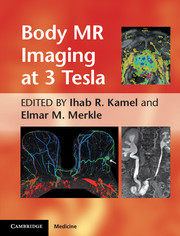Book contents
- Frontmatter
- Contents
- Contributors
- Foreword
- Preface
- Chapter 1 Body MR imaging at 3T: basic considerations about artifacts and safety
- Chapter 2 Novel acquisition techniques that are facilitated by 3T
- Chapter 3 Breast MR imaging
- Chapter 4 Cardiac MR imaging
- Chapter 5 Abdominal and pelvic MR angiography
- Chapter 6 Liver MR imaging at 3T: challenges and opportunities
- Chapter 7 MR imaging of the pancreas
- Chapter 8 MR imaging of the adrenal glands
- Chapter 9 Magnetic resonance cholangiopancreatography
- Chapter 10 MR imaging of small and large bowel
- Chapter 11 MR imaging of the rectum, 3T vs. 1.5T
- Chapter 12 Imaging of the kidneys and MR urography at 3T
- Chapter 13 MR imaging and MR-guided biopsy of the prostate at 3T
- Chapter 14 Female pelvic imaging at 3T
- Index
- Plate section
- References
Chapter 7 - MR imaging of the pancreas
Published online by Cambridge University Press: 05 August 2011
- Frontmatter
- Contents
- Contributors
- Foreword
- Preface
- Chapter 1 Body MR imaging at 3T: basic considerations about artifacts and safety
- Chapter 2 Novel acquisition techniques that are facilitated by 3T
- Chapter 3 Breast MR imaging
- Chapter 4 Cardiac MR imaging
- Chapter 5 Abdominal and pelvic MR angiography
- Chapter 6 Liver MR imaging at 3T: challenges and opportunities
- Chapter 7 MR imaging of the pancreas
- Chapter 8 MR imaging of the adrenal glands
- Chapter 9 Magnetic resonance cholangiopancreatography
- Chapter 10 MR imaging of small and large bowel
- Chapter 11 MR imaging of the rectum, 3T vs. 1.5T
- Chapter 12 Imaging of the kidneys and MR urography at 3T
- Chapter 13 MR imaging and MR-guided biopsy of the prostate at 3T
- Chapter 14 Female pelvic imaging at 3T
- Index
- Plate section
- References
Summary
MR imaging technique
New MR imaging techniques that limit artifacts in the abdomen have increased the role of MR imaging in detection and characterization of pancreatic disease. Advantages of imaging at 3T compared with 1.5T include thinner section acquisition (typically 2.5 mm versus 5 mm at 1.5T), higher matrix (typically 340 × 516 compared with 192 × 256), and high quality of T1-weighted three-dimensional (3D) gradient echo imaging [1]. Standard sequences at 3T, which include breath-hold T1-weighted 3D gradient echo sequences, fat suppression techniques, and dynamic administration of gadolinium chelate, have resulted in image quality of the pancreas sufficient to detect and characterize focal pancreatic mass lesions smaller than 1 cm in diameter, and to evaluate diffuse pancreatic disease. MR cholangiopancreatography (MRCP) images acquired in a coronal oblique projection to delineate the pancreatic and bile duct is a useful addition. MRCP permits good demonstration of the biliary and pancreatic ducts to assess ductal obstruction, dilation, and abnormal duct pathways. The combination of parenchyma-imaging sequences and MRCP provides comprehensive information to evaluate the full range of pancreatic disease.
- Type
- Chapter
- Information
- Body MR Imaging at 3 Tesla , pp. 82 - 110Publisher: Cambridge University PressPrint publication year: 2011



